Space situational awareness (SSA) is emerging as one of the major battlegrounds of the 21st century. For Australia – a world leader in the development of SSA capability – the capacity will provide an area of strategic advantage for the nation and its allies, highlighting the importance of SSA.
The increasing dependence and vulnerability of space-based intelligence, surveillance and communications assets, combined with the ever-advancing pace of anti-satellite technology, is opening avenues for Australia to leverage domestic expertise to develop a credible, cost-effective ‘multi-domain’ force multiplying, space situational awareness capability.
While platforms like the Army's growing web of integrated, networked platforms like the Boxer CRV, next-generation air and missile defence systems, Navy's Hobart and Hunter Class ships, the fifth-generation F-35 Joint Strike Fighter, P-8A Poseidon and the E-7A Wedgetail are individually highly capable platforms – their reliance on integrated, secure and highly capable space-based networks is a key and rapidly exploitable vulnerability.
This vulnerability is not unique to Australia and its period of modernisation and capability development – rather, every modern military, including those of major powers like the US, Russia, China and India, are all equally dependent upon the uncontested access to their own integrated space-based communications, intelligence and surveillance networks.
SSA provides Australia with a area of natural competitive advantage compared with other nations. Ben Greene, EOS group chief executive, explained the unique position Australia finds itself in: "As a nation, Australia has a natural advantage in space services, but we have to leave the door open to disruptive technologies being developed to help increase Australian access because in some of these disruptive technologies everyone, including Australia, is starting from the same basic levels."
In the broadest sense, SSA may be defined as a knowledge of the energy and particle fluxes in near-Earth space, natural and artificial objects passing through or orbiting within this space, including the past, present and future state of these components. The realm of near-Earth space may be left rather vague at this stage. It is definitely within cis-lunar space, but extends to an Earth-radius of at least 100,000 kilometres to include nearly all man-made objects currently in orbit.
The Space Foundation defines SSA as "the ability to view, understand and predict the physical location of natural and man-made objects in orbit around the Earth, with the objective of avoiding collisions".
Dr Greene added, "When it comes to SSA capabilities, Australia is one of the top five major global space powers, however, at a national level the indigenous capability is essentially zero – while Australia hosts foreign sensors, there isn't that uniquely national capability at this point in time."
Recognising the opportunity presented by the growing field of SSA and the tactical and strategic advantages SSA can provide, why isn't Australia focusing on developing this key tactical and strategic force multiplier, particularly as peer competitors like Russia and China continue to take more interventionist stances towards space-based systems?
Enhancing SSA and 'soft kill' capabilities
Australia's world-leading SSA capabilities, combined with renewed government focus on developing an offensive domestic cyber capabilities, domestic development of directed-energy weapons to 'dazzle' or 'blind' competitor space assets, and the nation's growing electronic warfare capabilities, provide avenues for Australia to develop a complementary 'soft kill' capability.
Australia's world-leading JORN network and the Harold E Holt base outside of Geraldton in Western Australia, combined with the continuing development of ionosphere scanning technology and the development of space-based tracking and related situational awareness capabilities by local companies (including world leading companies, like EOS Space Systems, Sabre Astronautics and their joint participation in the US Space Fence program), additionally supports the nation's push to develop a credible SSA and soft kill capability.
The rapid development of peer and near-competitor anti-satellite and counter-space capabilities, recently exemplified by the successful Indian anti-satellite weapons test and the resulting threat of space debris, requires the development of a robust and considered Australian response – enabling the nation to protect and deter its sovereign space interests while supporting the long-term development of Australia's own sovereign space capabilities.
Dr Greene added, "The importance part of SSA and the way it feeds into a more interventionist approach toward space is the need to establish and maintain an extensive intelligence database to make sure that any action against space debris doesn't have a negative impact on the broader space environment throughout the various levels of orbit."
'Joint Force' supporting the SSA capability
The modernisation of the ADF – namely the introduction of next-generation, multi-domain capabilities across each of the ADF's branches – provides interesting avenues for Australia to develop a reliable, survivable and complementary counterspace and anti-satellite capability.
In particular, the Navy's acquisition of advanced surface combatants, in the Aegis-powered Hobart and Hunter Class destroyers and frigates, serves as the basis of the sea-based leg of Australia's own counterspace capability – albeit a final resort option given the dangers posed by space debris.
The power of the Aegis Combat System and continued upgrades in development and in service with the US Navy and Japanese Maritime Self-Defense Force, in the form of ballistic missile defence (BMD) capability packages added into the Aegis system and advancing SPY radars supporting targeting and tracking by advanced SM-series missiles, provides avenues for Australia to leverage these capabilities in conjunction with the nation's major strategic partner.
Developing and implementing these naval capabilities does require the modernisation of Australia's Aegis fleet to incorporate the BMD capabilities, as well as the introduction of the SM-3 series missiles, provides the nation with a credible anti-satellite deterrent capability.
Meanwhile, the nation's recognised leading-edge phased-array radar and SSA capabilities through companies like CEA Technologies and EOS Space Systems provide further avenues for Australia to develop a niche, leading-edge capability to fulfil Australia's unique tactical and strategic requirements.
Let us know your thoughts in the comments section below, or get in touch with









